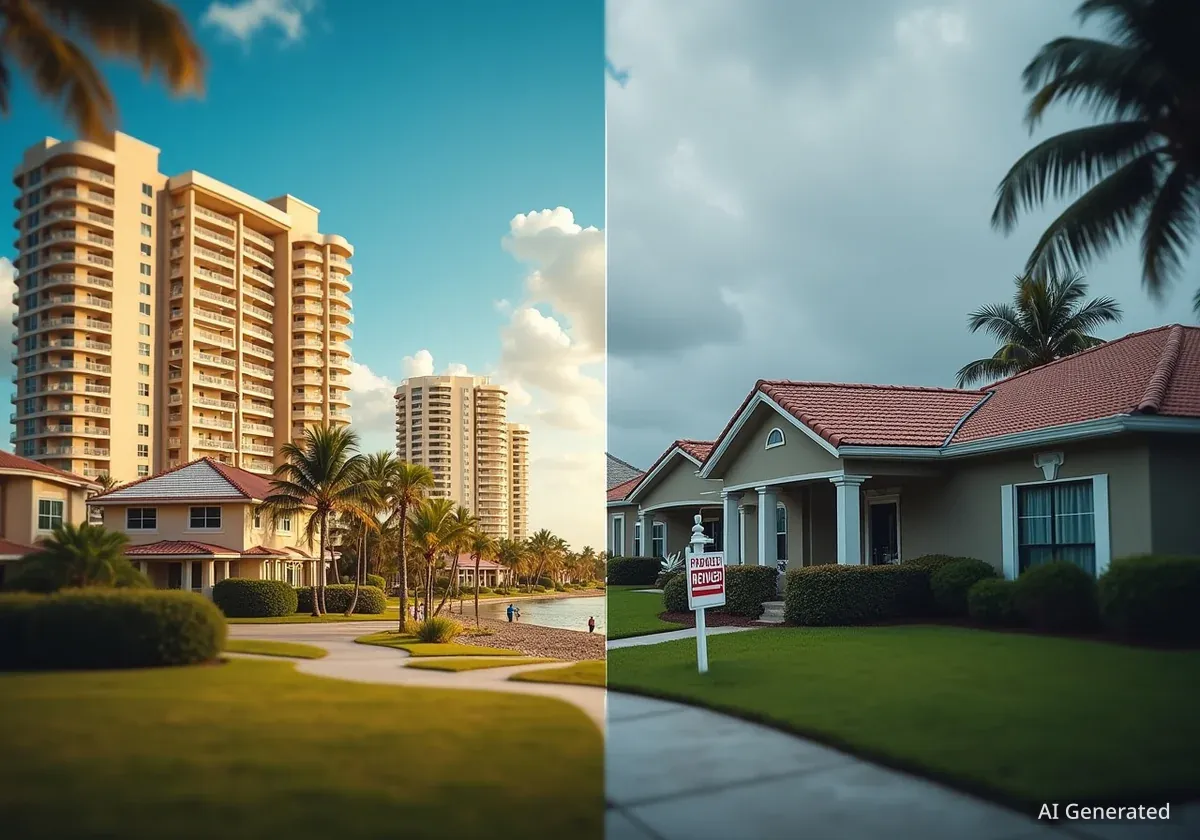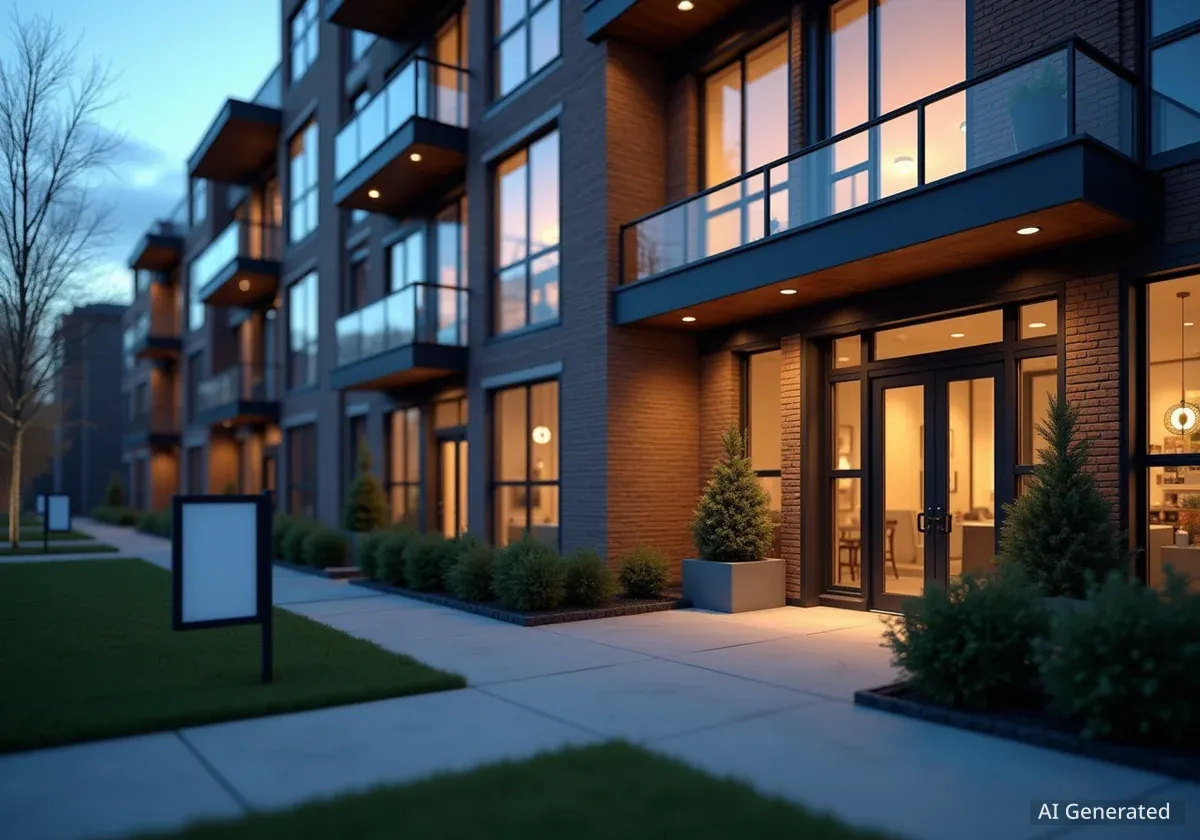Just 40 miles apart on Florida's Gulf Coast, the real estate markets of Naples and Cape Coral are telling two vastly different stories. While Naples is experiencing a luxury construction boom with condominium sales reaching $70 million, the nearby city of Cape Coral is navigating a difficult correction where nearly 8% of homeowners owe more on their mortgages than their properties are worth.
Local real estate experts describe the situation not as a collapse, but as a market "rebalancing" following a period of intense growth. They point to distinct buyer demographics and wealth levels as the primary drivers behind the divergence, highlighting the resilience of the high-end market in Naples while other areas adjust to new economic realities.
Key Takeaways
- Naples is a thriving luxury real estate hub, with developers launching multi-million dollar projects to meet demand from high-net-worth buyers.
- Cape Coral was recently identified as a struggling market, with a significant number of homeowners underwater and property values declining over the past year.
- Industry leaders attribute the disparity to a natural market correction after a 75% price surge during the pandemic, rather than a widespread downturn.
- The two cities, though geographically close, attract fundamentally different buyer profiles, from ultra-wealthy primary residents in Naples to a more price-sensitive demographic in Cape Coral.
- Despite optimism in the luxury sector, rising insurance costs and the persistent threat of hurricanes remain significant challenges for the entire Southwest Florida region.
A Sharp Divide in Southwest Florida
The contrast between the two cities is stark. In Naples, developers like Kolter Urban are constructing exclusive high-rises such as the Olana Residences, a 12-unit building where properties are expected to command eight-figure prices. Brokers in the area are handling transactions for condos valued as high as $70 million and beachfront villas priced at $35 million.
Meanwhile, a report from The Wall Street Journal in late June labeled Cape Coral "America’s worst housing market." The report cited data showing that home prices had fallen in 12 of the preceding 13 months and that nearly 8% of its homeowners were underwater on their mortgages—a higher percentage than anywhere else in the nation at the time.
According to Zillow data, the median home price in Naples stands significantly higher than Cape Coral's median of $343,431. Budge Huskey, CEO of Premier Sotheby's International Realty, notes that a typical waterfront property in Naples can cost between $5 million and $10 million.
Expert Analysis Points to Market Rebalancing
Local industry leaders suggest that the negative headlines about Cape Coral are an oversimplification of a complex market adjustment. "If it was a single word, I would say rebalancing," Huskey stated, explaining that the area is recovering from an unsustainable growth period.
"We all saw that article, and we were scratching our heads a bit, and we thought it was a little bit sensationalized," Huskey said. "It was certainly very incomplete as far as the total picture is concerned."
He explained that during the pandemic, housing values in the broader Fort Myers and Cape Coral area increased by approximately 75%, reaching a median of $419,000. This rapid appreciation was followed by a pullback caused by a combination of factors, including the impact of hurricanes and a natural decrease in buyer demand after the surge.
Understanding 'Underwater' Mortgages
When a homeowner is "underwater" or has "negative equity," it means the outstanding balance on their mortgage loan is higher than the current market value of their home. This can happen when property values fall after a purchase, making it difficult for the owner to sell the property without taking a financial loss.
Ed Jahn, Senior Vice President at Kolter Urban, added that markets like Cape Coral can experience more significant price fluctuations. "In the Naples area, you're not seeing that up and down fluid fluctuation in the pricing," he observed, attributing the stability to a different economic foundation and buyer profile.
Different Buyers, Different Destinies
The core reason for the market divergence lies in the distinct demographics the two cities serve. "The fact is that the distance between them is within an hour, but they are radically different in terms of buyer profile and audience in general," Huskey clarified.
Naples has successfully positioned itself as a premier destination for the ultra-wealthy, attracting buyers not just from traditional markets like New York but also from Texas and California. These buyers are often seeking primary residences, driven by factors like Florida's favorable tax laws and the city's unique lifestyle.
Migration of Wealth
According to one study, Florida has seen a significant influx of high-income individuals. A recent report indicated that billions of dollars in annual income have moved from states like New York to Florida, bolstering demand in luxury real estate markets like Naples.
"The Naples market, in the past, the season was short. What we're seeing now are many of the buyers are not just a secondary residential owner. They're becoming primary," Jahn noted. He added that these buyers prioritize convenience and the "lock-and-leave lifestyle" offered by luxury condominiums.
In contrast, the Cape Coral market appeals to a different price point and level of wealth, making it more susceptible to broader economic pressures like rising interest rates and inflation.
Navigating Regional Challenges
Despite the robust health of the Naples luxury market, the entire Southwest Florida region faces persistent challenges. The threat of hurricanes and the associated rise in insurance costs are significant concerns for all homeowners.
Last year, homeowners in South Florida experienced insurance cost increases of around $500 per month, according to the National Association of Realtors. This adds a substantial financial burden to property ownership in the state.
Developers and real estate professionals are adapting to these realities. "New product is being built, considerably raised, hardened… but with that transformation comes additional expense," Huskey said. These modern building standards, while costly, are designed to attract affluent buyers willing to pay a premium for safety and security.
Both Huskey and Jahn remain optimistic about the long-term outlook for the region. "We are very confident that we’re gonna have an amazing season this year, not only in Naples, but across our platform," Jahn said. Huskey concluded, "We're incredibly optimistic about the long-term attraction of our markets all across southwest Florida."





